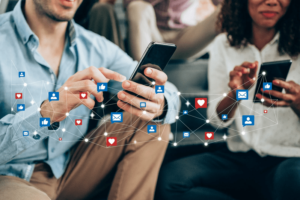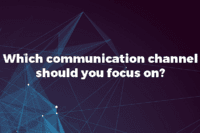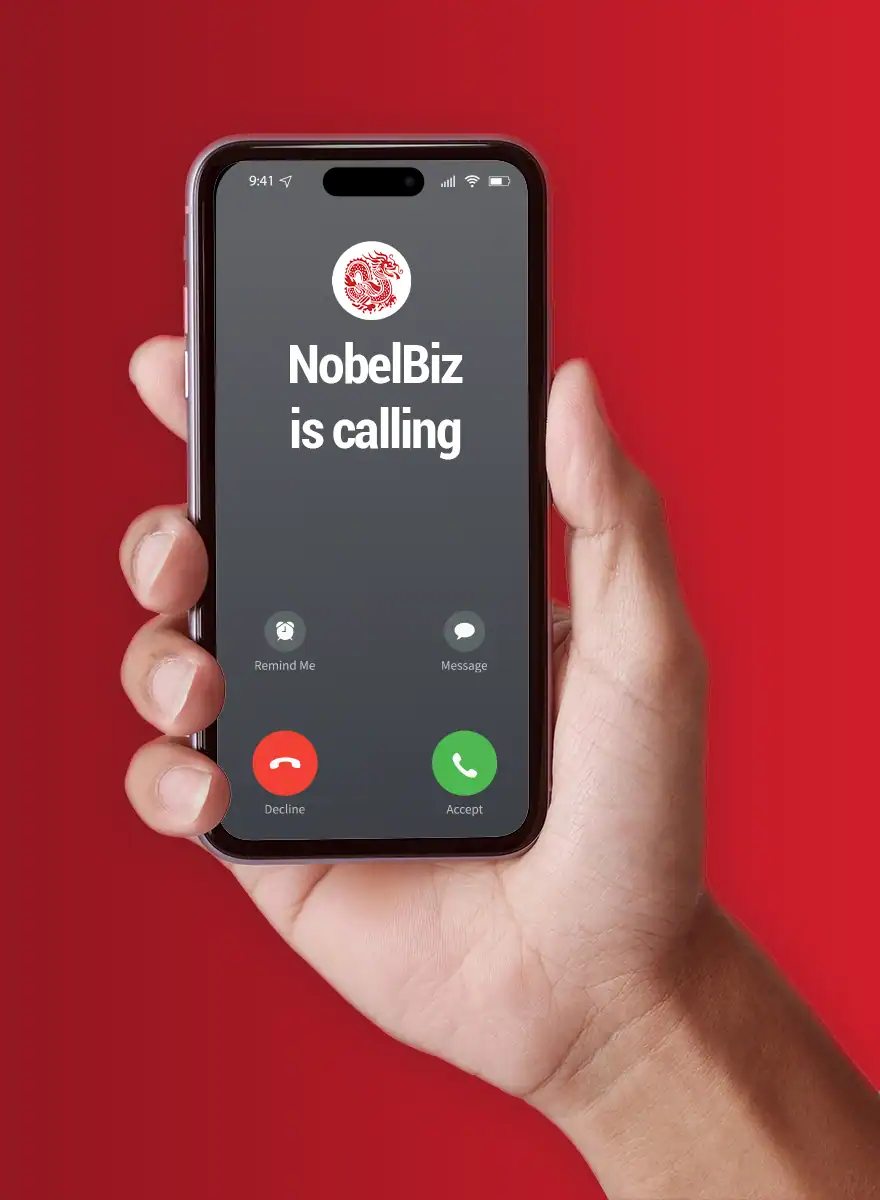Website, email, social media, SMS, instant messaging, and mobile applications: the evolution of communication channels over the last two decades has increased the number of available points of interaction between businesses and their consumers. Traditional channels have evolved on one hand and new ones have arisen on the other, as a result of the introduction of new digital technologies and new ways of communication. For the contact center industry, customer relationships management has also dramatically shifted.
This revolution of channels must enable contact centers to make client relationships even more distinctive by personalizing them and creating a genuine consumer experience. After all, the customer relationship is the point of contact between a brand and its consumers.
Customer loyalty can be increased by providing excellent customer service. Otherwise, if the customer service is less than perfect, the client will naturally go to the competition. Now, the natural question would be, what communication channels should your contact center focus on to manage customer interactions?
The choice of communication channels is not up to contact centers
Indeed, it’s not the contact center nor the brand who determines the communication channel, that choice is primarily up to the clients.
That is why contact centers must pinpoint which channels consumers utilize the most and which create the greatest customer experience. If you take a company with a client base that is 45 years old on average that utilizes solely social media has little interest in investing in this channel to engage with its consumers. It is the contact center responsibility to discover the channels utilized by its customers through data analysis and by taking a steadfastly customer-centric attitude. The modalities of the customer connection are primarily determined by the client’s choices. However, there is no one size fits all in communication channels, so let’s analyze and dissect each one of them.
Telephony is still number 1

With the introduction of the IP telephony solutions, voice, the traditional channel of customer relations, underwent a change and remains essential for any successful customer relations management.
While we can all agree that automation of customer interactions is vital for organizations in order to cut costs, the truth remains that human touch through the telephone is highly valued by customers. As it allows for participation on both sides, voice is the sole route capable of restoring emotions. Voice establishes a genuine sense of trust between your organization and its clients. Hence why phone calls are still valued because they provide a means of human interaction. Emotion is important in ensuring that the client is satisfied at the end of the line.
The telephone also remains the number 1 communication for inbound and outbound campaigns, since it has progressed from a simple listening line to a modern communication device. Voice digitization prospects are more than promising now, thanks to advanced IP telephony solutions.
Now contact centers can also give customer service a voice, from IVR to Chatbot and so on. Finally, call data may be connected to consumer knowledge gathered at other points of contact. The tracking of customer journeys will no longer cease when the client calls you. When the adviser answers the phone, the consumer is recognized for customized management.
Emails are simple but effective
E-mail, more often known as “email,” the legendary and revolutionary successor to the fax, has likewise undergone its own upheaval.
In the professional world, e-mails have traditionally been utilized as a basic form of communication. However, when you consider the numerous software solutions available today, this simplistic communication channel has evolved into a powerful instrument in the service of customer interactions.
Whether it is through ticketing tools for better customer service management or the implementation of very elaborate mailing campaigns to communicate with your customers, email has evolved, and its possibilities have multiplied!
And it goes without saying that this progress pleases customers. Despite its antiquity, e-mail is viewed as comforting due to the “paper trail” aspect.
The rise of Social Media
In 2021, you can’t discuss client interaction and customer experience without mentioning social media. We’re talking about Facebook, Twitter, Telegram, Whatsapp… the list of these platforms is lengthy, and their applications are nearly limitless.
All of them are now part of the must-haves in customer relationship management since they allow you to create a true client base and community around the brand. Despite being reviled and derided as a medium in which Internet users are often prone to blunders, social media are a strong tool for establishing a creative, unique, digital client relationship.
A plethora of functions and advantages are available to contact centers within social media, such as:
- Communication with the audience is direct and individualized,
- More contact options to effectively manage requests from a larger number of clients,
- Dissemination of your customer service values and key facts,
- Quality prospection through segmentation that is so accurate that it may be obtained at a cheap cost,
- Allow other customer service channels to handle more queries,
- More engagement to increase audience and loyalty towards the brand.
WebChat
WebChat, which just emerged a few years ago, is quickly becoming a must-have for a successful client relationship. The concept is a window that is embedded on the company’s website. It serves as a private messaging service between an Internet user and a customer care representative.
The Webchat’s strength is its near-instantaneous nature. It provides the necessary humanization of contacts to your client connection without fully deploying a customer care agent (However, the latter can indeed manage several conversations at the same time).
While WebChat borrows some of the human interaction that the telephone provides, it does not allow for the development of relationships that the latter does. WebChat, in fact, does not seek to solve complicated problems and queries where only the voice channel remains useful due to its contextual, more complex, and highly immediate structure. In laymen’s terms, WebChat is an excellent communication channel for simple and quick requests that relieve the workload of your agents.
Which communication should you focus on?
Following trends from the industry is a major mistake that may be costly for your contact center because your consumers and their expectations are not the same as your competition’s. Your objective is to build a one-of-a-kind customer experience with your consumers, not to just copy the newest trends, as your customers may not be open to that. Knowing your customer is more important than knowing what your competition does.
Customers’ presence on a channel, on the other hand, does not guarantee that they will be receptive to it. Several criteria must be considered in order to make an informed and strategic decision.
Criteria 1: Customer’s habits
 The first consideration for selecting a communication channel is clearly dependent on the habits of your customers. To assist you in your decision, you must divide your consumers based on numerous characteristics such as age, gender, socio-professional category, jobs, etc. Here you can include virtually anything that can help you better understand your consumers, their typologies, and their various demands so that customization is done to the best of your ability.
The first consideration for selecting a communication channel is clearly dependent on the habits of your customers. To assist you in your decision, you must divide your consumers based on numerous characteristics such as age, gender, socio-professional category, jobs, etc. Here you can include virtually anything that can help you better understand your consumers, their typologies, and their various demands so that customization is done to the best of your ability.
For example, you may categorize the most popular channels based on age:
- In a professional environment, the telephone and email are preferred for generation X, i.e. the 40-55-year-olds today; nevertheless, it should be emphasized that they also utilize WebChat to communicate with their favorite brands.
- Generation Y and Millenials are extremely active on social media. However, take care to select networks that are truly suited to your target audience and message: Facebook users are not the same as Telegram users. They are likewise receptive to SMS and chat, but their response demand is considerably higher and faster.
As a result, it is critical to understand the key categories of your client base. However, these metrics should be interpreted with caution. If they apply to the majority, they may not apply to a specific target for a specific brand. It is your responsibility to determine where clients are present and responsive by analyzing data at the end of your campaigns.
Criteria n°2: based on your customer’s type
One of the most important criteria is also the customer relationship to a brand. It is therefore necessary to deliver a tailored message based on these conditions. Let’s take as an example a new client and a long-time customer. It is obvious that they do not have the same expectations, and the work needed of your agents will not be the same. Furthermore, your agent will have much more information about your loyal and long-term client, which allows for a truly tailored and personalized message. While the new client will require more attention and convincing.
In this instance the ball is in your court, It’s up to your contact center to choose the best method to split these clients and choose the optimal communication channel for each circumstance. As a manager, you may also categorize your consumers based on the approach you want to use for your campaign: loyalty, cross-selling, re-purchase, and so on.
Criteria n°3: The nature of your campaign
When deciding on a communication channel, you should also consider the nature of your campaign and the message you want to deliver to your clients. For example, if you handle a helpdesk, sending a technical guideline of your product or service through WhatsApp would be improper.
When delivering an essential message, providing a thorough explanation, or making rapid contact, the phone or e-mail are frequently the best options. Similarly, a professional speech on a service follow-up can be delivered over the phone or over instant messaging to ensure that all explanations are fully received.
Criteria n°4: Customer Journey Phase
The stage of a customer’s purchasing journey can also heavily influence the choice of the right communication channel choices. Consider sales as an example:
- During the sale: Your agents’ goal is to give prompt responses so that the consumer does not abandon his purchase. In this instance, the client must be able to contact your contact center or discover his options. In this case, a WebChat will allow you to respond to your customers’ inquiries in real-time. A WebChat, in this case, will not only be a way of communication for the client but will also serve as a perfect replacement for a physical vendor.
- After-sale: You can choose to contact a client through email or phone to convey loyalty and survey activities. If a client is dissatisfied, he should be able to readily contact you to discuss his concerns. It is therefore critical to recontact them through the most appropriate channel in order to address their complaint.
Criteria n°5: Your Contact Center Capabilities
 The last criteria and the most important one for your organization are your capabilities as a contact center. That means knowing your restrictions, goals, limits, and the environment of your industry. In other words:
The last criteria and the most important one for your organization are your capabilities as a contact center. That means knowing your restrictions, goals, limits, and the environment of your industry. In other words:
- It would be unwise to increase your communication channels: if you don’t have the technological and human resources to do so. If you wish to contact your customers via phone but there are too many of them compared to the number of agents, or you don’t have the proper telephony solution to handle it. You will need to segment your consumers based on your contact center capabilities and select the best clients from your database to contact.
- Pay attention to your industry’s restrictions and practices: Debt collection, for example, usually works through because clients are accustomed to it. There are other industries where internet communication is extremely challenging and e-mail communication is more common. For example, the insurance and automobile industries are increasingly utilizing the web to call in order to convert their website traffic.
To be successful with your campaign strategy, you must establish a cohesive message within your agent script and coordinate communication across all channels. In any event, you will need all of your customer’s information in order to select the appropriate channel and customize this message in terms of phrasing, arguments, and linguistic components within the script, as well as style and presentation. In that regard, we see the significant advancement of CRM tools and capabilities.
The choice doesn’t matter in the Omnichannel Context
The increased complexity of client journeys has resulted from the variety of channels. Omnichannel behavior is the finest example of this: consumers spend their time switching from one channel to another, for example, starting their shopping adventure on their mobile phone and then finishing their order on their computer before picking up their package in-store. These consumers will expect your contact center agents to know their history of purchase, their information, and their past interactions with the brand.
Choosing the right channels is a strategic and vital decision for your contact center. Chances are, your organization doesn’t need more than two or three of them. Exceeding this number can lead to communication problems, unaddressed messages, inconsistent quality of service, poor KPIs, and overloading your agents. Especially if you don’t have the right technology to keep up with the pace.
In that regard, a true Omnichannel technology and cloud contact center solution such as NobelBiz Omni+, not only allows your agents to navigate seamlessly from one channel to another but also to ensure consistency in the customer journey while delivering excellency in customer experience.

Michael McGuire is a contact center industry expert with almost two decades of experience in the space. His experience includes roles as Director of Contact Center Digital Transformation at NobelBiz, and as Director of Operations at FLS Connect, managing multiple call centers. As President of Anomaly Squared and Targeted Metrics, Michael successfully transitioned companies into remote operations and significantly boosted revenues. With a strong background in customer service, leadership, strategic planning, and operations management, Michael excels in driving growth and innovation in the call center space.
Mike is also a proud Board Member for R.E.A.C.H Trade Group, promoting consumer protection and satisfaction and Co-host of the Off Skripted Podcast – a show about Life, Call Centers and everything in between.







